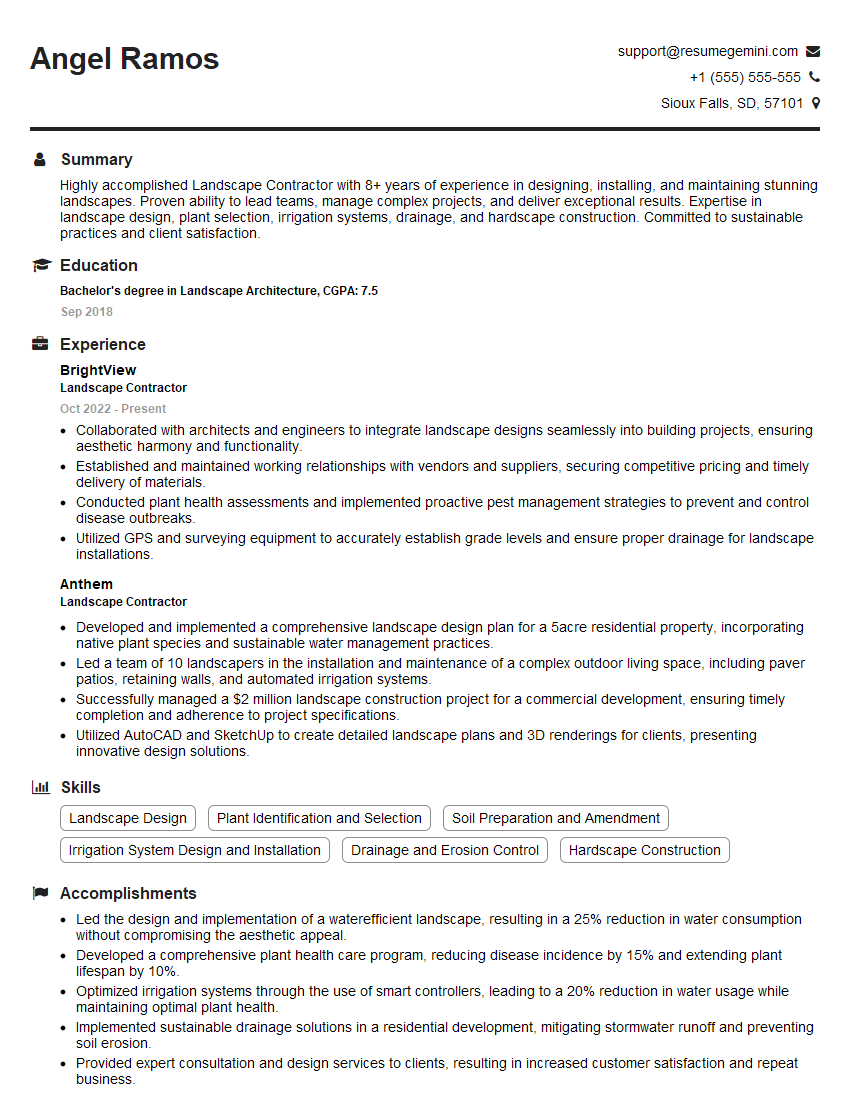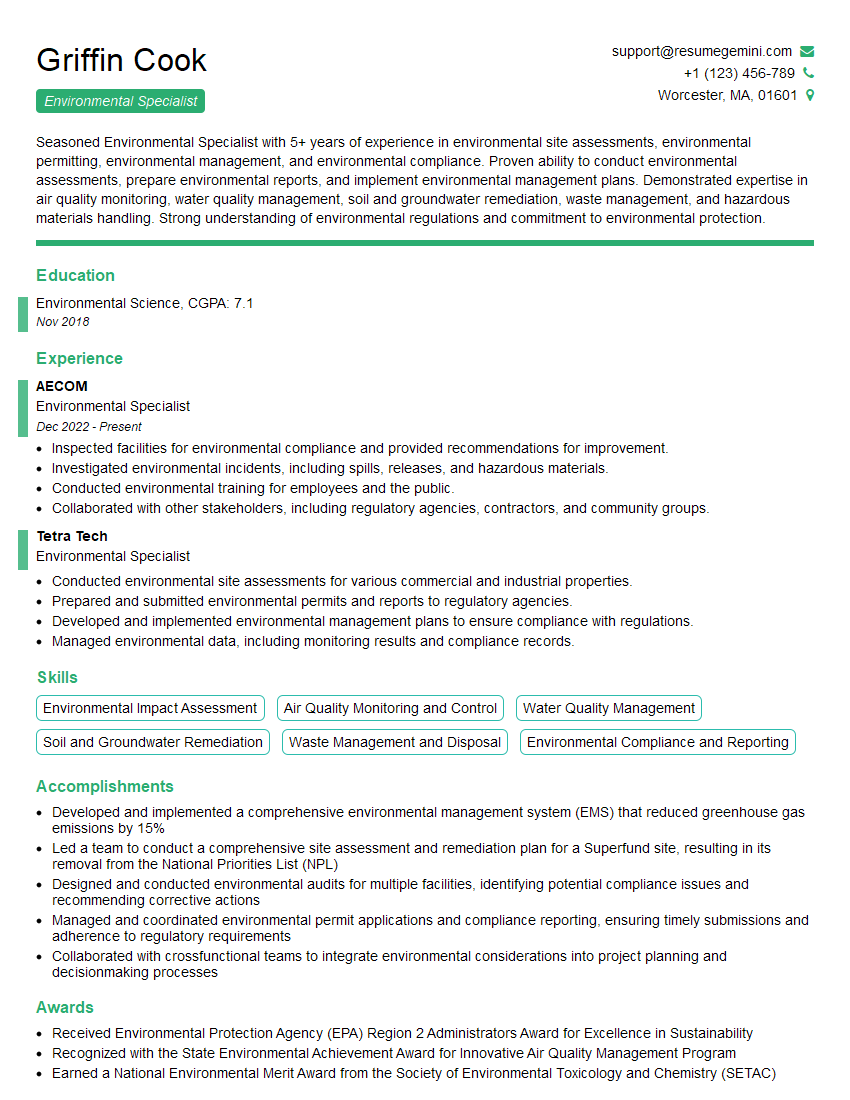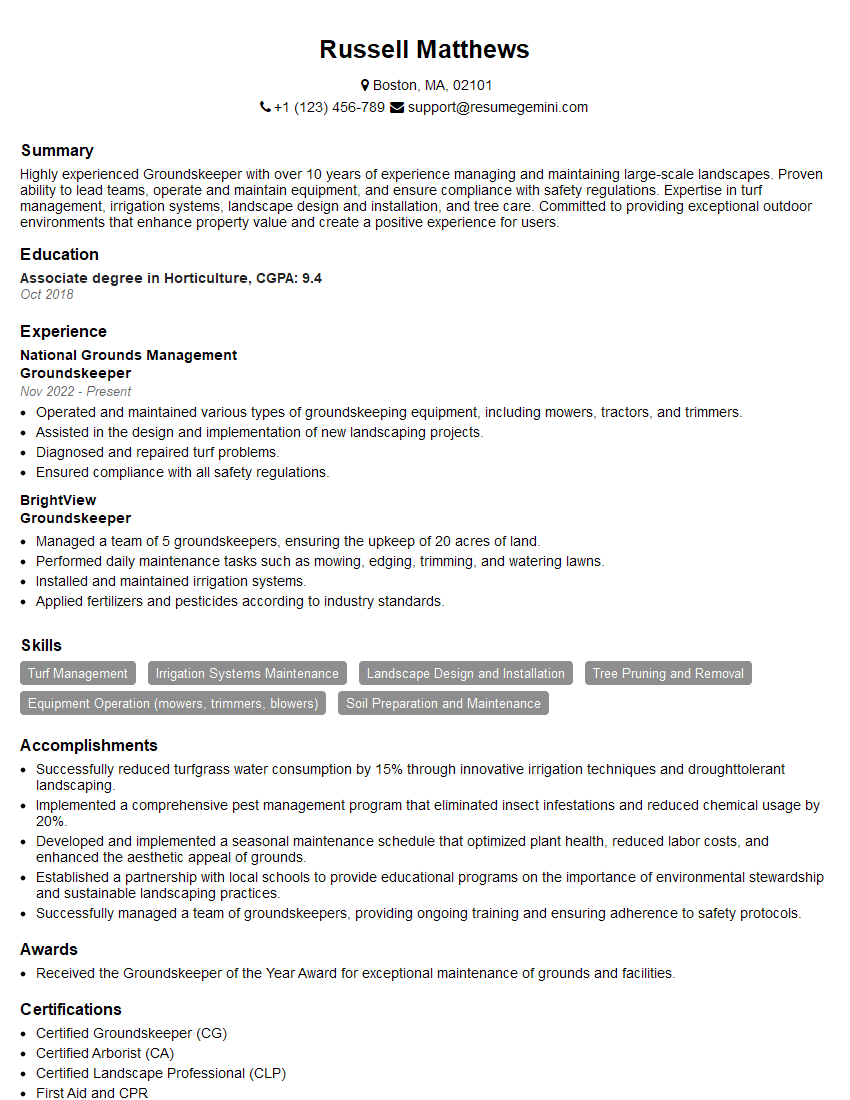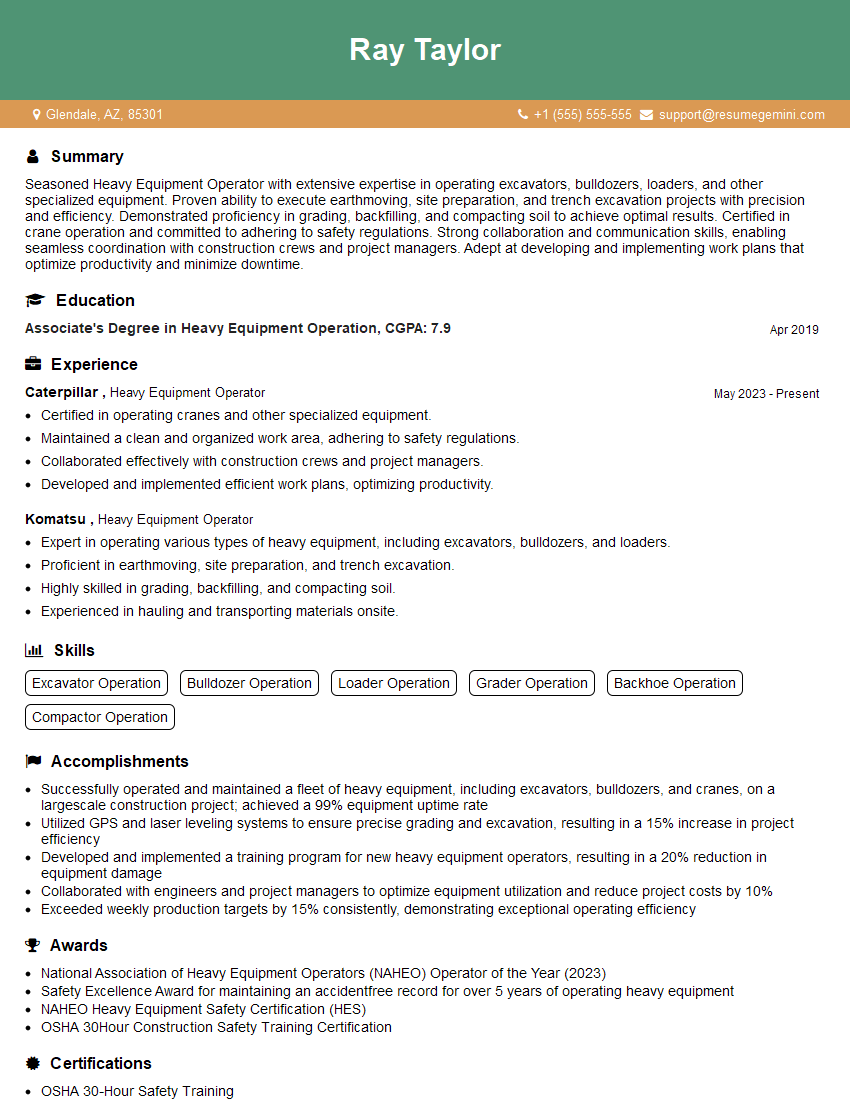Interviews are opportunities to demonstrate your expertise, and this guide is here to help you shine. Explore the essential Root Removal interview questions that employers frequently ask, paired with strategies for crafting responses that set you apart from the competition.
Questions Asked in Root Removal Interview
Q 1. Describe your experience with various root removal methods.
Root removal methods vary depending on the size of the tree, the accessibility of the roots, and the desired outcome. My experience encompasses a range of techniques, including:
- Stump Grinding: This is ideal for smaller trees and involves using a machine to grind the stump and roots below ground level into small chips. I’ve used this extensively for residential properties where minimal disruption is key.
- Excavation: For larger trees or when complete root removal is necessary, excavation is employed. This involves manually or mechanically digging out the roots, often requiring heavy machinery like excavators. I’ve successfully used this method for large-scale projects like commercial developments.
- Chemical Removal: This method uses herbicides to kill the roots over time. It’s less invasive than other methods but slower and best suited for smaller trees or situations where excavation is impractical. I’ve found this useful in environmentally sensitive areas.
- Combination Methods: Often, the most effective approach involves a combination of methods. For example, we might use stump grinding to reduce the stump’s size and then excavate the remaining larger roots. This approach ensures thoroughness while optimizing efficiency.
Choosing the right method is crucial and requires careful assessment of each project’s specific requirements.
Q 2. What safety precautions do you take during root removal?
Safety is paramount in root removal. My safety protocols include:
- Proper Personal Protective Equipment (PPE): This includes safety glasses, gloves, steel-toed boots, and hearing protection. Depending on the project, I might also use hard hats and high-visibility vests.
- Site Assessment: Before beginning any work, I thoroughly assess the site for potential hazards, including underground utilities, other trees, and nearby structures. Utility marking services are always employed.
- Safe Machine Operation: All machinery is operated according to manufacturer guidelines and with appropriate training. Regular maintenance is performed to ensure safe operation.
- Traffic Control: For projects near roadways or public areas, I ensure proper traffic control measures are in place to prevent accidents.
- Emergency Procedures: A comprehensive emergency plan is in place, including communication protocols and emergency contact information.
Safety isn’t just a checklist; it’s an ingrained mindset that guides every decision I make on the job.
Q 3. Explain the difference between stump grinding and root excavation.
Stump grinding and root excavation are both common root removal methods, but they differ significantly in their approach and results.
- Stump Grinding: This method focuses solely on removing the above-ground stump and the upper portion of the root system. The remaining roots are left in the ground, which can decompose over time. It’s quick, relatively inexpensive, and suitable for smaller trees. Think of it like trimming a very stubborn bush.
- Root Excavation: This involves the complete removal of the entire root system, excavating the ground to access and remove all roots. This method is more labor-intensive, expensive, and disruptive but ensures complete root removal. This is necessary when you want to eliminate the tree’s potential for regrowth or need the space for construction. It’s like completely uprooting a weed.
The choice between the two depends largely on the project’s scope and objectives.
Q 4. How do you identify different tree species and their root systems?
Identifying tree species and their root systems requires a combination of observation and knowledge. I use several methods:
- Visual Identification: I begin by observing the tree’s leaves, bark, and overall shape to identify the species. Years of experience have provided me with a solid understanding of common and less common tree types in the area.
- Root System Characteristics: Different species have different root system patterns. For instance, some species have shallow, widespread roots, while others have deep taproots. The size and branching patterns of the roots provide additional clues.
- Resources: I utilize field guides, tree identification apps, and online resources to confirm my identification. When in doubt, I always double-check my findings.
Accurate identification is crucial as different species have varying root depths and complexities, impacting the most effective removal strategy.
Q 5. What equipment are you proficient in operating for root removal?
My proficiency extends to various equipment crucial for efficient and safe root removal:
- Stump Grinders: I’m experienced operating different models of stump grinders, from small, portable units to larger, more powerful machines for bigger jobs.
- Excavators: I am skilled in operating excavators of various sizes, using different attachments like buckets, rippers, and grapples for efficient root extraction.
- Backhoes: I’m proficient in using backhoes for both digging and lifting, facilitating precise root removal and loading of debris.
- Skid Steer Loaders: I’m experienced using skid steers to maneuver in tight spaces, manage debris, and assist with excavation efforts.
- Chainsaws (with proper safety): Carefully used for selective cutting of larger roots when necessary before excavation.
Regular maintenance and safety checks are performed on all equipment before, during, and after each project.
Q 6. How do you assess the structural integrity of nearby structures during root removal?
Assessing the structural integrity of nearby structures during root removal is a crucial aspect of responsible work. My assessment involves:
- Visual Inspection: I carefully examine the foundations, walls, and other structural elements of nearby buildings for any signs of damage or distress.
- Distance Measurement: I measure the distance between the tree roots and the structures to determine the potential for root encroachment and damage.
- Root Mapping (when needed): In cases of large trees or structures close to the work area, employing ground penetrating radar or other mapping techniques to identify root locations might be necessary.
- Consultation with Engineers (if necessary): For complex projects or when I suspect structural concerns, I consult with structural engineers to provide professional opinions and guidance. This may include soil analysis reports.
Protecting nearby structures is a high priority, and thorough assessment minimizes the risk of unintended damage.
Q 7. What are the common challenges faced during root removal projects?
Root removal projects often present unique challenges:
- Unexpected Obstacles: Underground utilities, rocks, and other unexpected obstacles can complicate the process and delay completion. Proper site assessments can mitigate this.
- Root Complexity: Large and complex root systems can be exceptionally difficult to remove completely, particularly when intertwined with other roots or structures. Careful planning and the use of appropriate equipment are essential.
- Environmental Concerns: Protecting the surrounding environment, including soil and other vegetation, is a priority. Careful planning and techniques minimize environmental impact.
- Access and Space Constraints: Working in confined spaces or areas with limited access can pose logistical challenges. Careful planning and the use of appropriate equipment is crucial.
- Weather Conditions: Extreme weather conditions can halt progress and impact the safety of the project. Contingency plans for such scenarios are vital.
Effective project management, thorough planning, and the ability to adapt to unforeseen circumstances are key to overcoming these challenges.
Q 8. How do you manage soil erosion and compaction during root removal?
Soil erosion and compaction are major concerns during root removal, potentially leading to long-term site instability and environmental damage. We mitigate these risks through a multi-pronged approach.
Careful Excavation Techniques: We employ minimally invasive excavation methods whenever possible, using smaller equipment where appropriate to minimize soil disturbance. This reduces the exposed surface area vulnerable to erosion.
Erosion Control Measures: Before excavation, we implement temporary erosion control measures such as silt fences, straw bales, or geotextiles to trap sediment and prevent runoff. These barriers are strategically placed based on the site’s topography and anticipated water flow.
Compaction Mitigation: Heavy machinery can compact the soil, hindering water infiltration and plant growth. We minimize this by limiting heavy equipment usage where possible, using lighter machinery when feasible, and strategically placing equipment to avoid repeated passes in the same area. In some cases, we may utilize soil stabilization techniques after excavation, such as adding organic matter to improve soil structure and reduce compaction.
Re-vegetation: After root removal is complete, we promptly re-vegetate the area with appropriate plant species to stabilize the soil, prevent further erosion, and restore the site’s ecological balance. This is especially crucial on slopes or areas with high rainfall.
For example, on a recent project involving the removal of large tree roots near a stream, we used a combination of hand excavation near the stream bank, strategically placed silt fences to manage water runoff, and subsequently planted native grasses to stabilize the soil and prevent erosion.
Q 9. Explain your experience with root removal in various soil types.
My experience spans a wide range of soil types, each presenting unique challenges. Clay soils, for instance, are incredibly dense and tenacious, making root removal a slow and labor-intensive process. We often utilize specialized equipment like powerful root grinders and excavation tools designed for this soil type. Sandy soils, conversely, are easier to excavate but present a higher risk of erosion and collapse. Careful planning and the implementation of robust erosion control measures are vital in these situations. Loamy soils typically represent a middle ground, offering a manageable balance between ease of excavation and stability.
I’ve also worked with rocky soils, requiring meticulous hand excavation and possibly the use of specialized rock-breaking tools to avoid damaging nearby structures or utilities. Each soil type requires a tailored approach, leveraging appropriate tools and techniques to ensure efficient and safe root removal while minimizing environmental impact.
For example, when removing roots from a very clay-heavy area, we had to use a combination of hydraulic excavators with specialized root rakes and then follow with a smaller excavator for the delicate final removal around utilities.
Q 10. How do you handle unexpected underground utilities encountered during excavation?
Encountering unexpected underground utilities is a serious safety hazard and can lead to costly delays and repairs. Our protocol begins with thorough pre-excavation surveys to identify potential utility locations. However, despite meticulous planning, surprises can occur. If we discover an unexpected utility, work immediately stops.
Safety First: The immediate priority is safety. The area is cordoned off, and all personnel are evacuated from the immediate vicinity.
Utility Company Notification: We immediately contact the appropriate utility company (gas, electric, water, etc.) to confirm the utility’s location, type, and status. This often involves a site visit from a utility representative.
Marked Location: Once the utility is confirmed, its location is precisely marked and documented.
Revised Excavation Plan: We work with the utility company to revise the excavation plan to safely avoid the utility. This may involve modifying the excavation path, using hand tools instead of machinery, or even halting work in that specific area.
Documentation: All incidents are thoroughly documented, including photographs, communications with the utility company, and any adjustments made to the excavation plan.
One instance involved discovering a previously unmapped gas line during a large-scale root removal project. Following our protocol, we immediately stopped work, contacted the gas company, and waited for their assessment. They marked the line’s precise location, allowing us to safely complete the project while adhering to strict safety standards.
Q 11. Describe your experience with different types of root grinders.
My experience encompasses a variety of root grinders, each suited for different tasks and soil conditions. Smaller, hand-held grinders are ideal for precision work in confined spaces or delicate situations near structures. Larger, track-mounted grinders, on the other hand, offer superior power and efficiency for removing extensive root systems. These machines can significantly speed up the process and reduce labor costs, especially on large projects.
Hydraulic Grinders: These are incredibly powerful and efficient, able to handle even the toughest roots. Their hydraulic operation provides precise control.
Mechanical Grinders: These are typically less expensive than hydraulic grinders but might require more manual labor.
Vertical Grinders: These are highly effective for pulverizing roots in a confined area.
The choice of root grinder depends largely on factors such as the size and density of the root system, the soil type, site accessibility, and the proximity of underground utilities and structures. For example, in a densely populated urban area, I would favor a smaller, more maneuverable grinder to minimize the risk of damage to nearby infrastructure. In contrast, for a large-scale clearing project in a rural setting, a heavy-duty, track-mounted grinder would be the most efficient choice.
Q 12. What are the environmental considerations for root removal?
Environmental considerations are paramount in root removal. Our approach focuses on minimizing disruption to the surrounding ecosystem and adhering to all relevant regulations. This includes careful planning, the use of environmentally friendly equipment and techniques, and responsible waste management.
Minimizing Soil Disturbance: We prioritize minimally invasive techniques to reduce soil erosion and compaction.
Protection of Water Resources: We take precautions to prevent sediment from entering waterways during and after root removal operations.
Responsible Waste Disposal: We ensure that all waste is disposed of properly in accordance with local regulations, prioritizing recycling or composting whenever possible.
Preservation of Existing Vegetation: We aim to preserve as much of the existing vegetation as possible, avoiding unnecessary damage to nearby plants and trees.
Habitat Restoration: After completion, we may engage in restorative planting to mitigate habitat loss and enhance biodiversity.
For instance, on a project near a sensitive wetland, we utilized specialized equipment and techniques to avoid disturbing the wetland ecosystem and implemented rigorous erosion control measures to prevent sediment runoff into the wetland.
Q 13. How do you determine the appropriate depth for root removal?
Determining the appropriate depth for root removal is crucial and depends heavily on the specific project goals. It’s not simply a matter of digging until you find no more roots. We need to consider several factors:
Root System Extent: The primary factor is the extent of the root system of the targeted plant(s). This often involves pre-project assessments and sometimes even root mapping technologies. We want to remove the majority of the substantial roots to prevent regrowth.
Project Objectives: Are we aiming for complete removal to facilitate new construction, or are we targeting a partial removal for landscape alteration? The depth required differs significantly between these goals.
Underlying Structures: The presence of underground utilities, foundations, or other structures dictates the maximum allowable excavation depth.
Soil Type: Soil type influences the depth and extent of the root system. Some plants may have deeper roots in sandy soils compared to clay soils.
Often, a phased approach is used. Initial excavation reveals the primary root system, then further excavation might be needed, always mindful of underground utilities and safety concerns.
For instance, removing tree roots for a new building foundation requires digging to a far greater depth than removing roots for a simple landscaping project. We’ll assess the foundation’s plans and the tree species to determine the depth necessary for both complete root removal and foundation stability.
Q 14. How do you manage waste generated during root removal projects?
Waste management is an integral part of responsible root removal. We follow a strict protocol to ensure minimal environmental impact.
Waste Segregation: We meticulously segregate waste materials on-site. This typically includes soil, roots, wood debris, and potentially other materials depending on the project’s specifics.
Recycling and Composting: Whenever possible, we prioritize recycling or composting organic materials such as wood debris and soil. This reduces landfill waste and promotes sustainability.
Disposal of Non-Recyclable Materials: Non-recyclable materials are disposed of according to local regulations, often through licensed waste disposal facilities. We maintain meticulous documentation to ensure compliance.
Soil Remediation: If soil contamination is suspected, we work with environmental specialists to remediate the soil before disposal or reuse.
For example, on a recent project, we composted the majority of the wood debris and used the excavated soil to improve other areas on the site, which reduced landfill waste and minimized the need for new topsoil. All other waste was properly disposed of and tracked according to our environmental compliance plan.
Q 15. What are your experience with root removal near foundations?
Root removal near foundations requires extreme care to avoid structural damage. My experience encompasses a wide range of techniques, from minimally invasive methods like air-spading (using compressed air to loosen soil around roots) for smaller roots to more extensive excavation for larger, more deeply entrenched systems. I always begin with a thorough assessment, often utilizing ground-penetrating radar (GPR) to visualize the root system’s extent before commencing any work. This allows for precise planning, minimizing the risk of damaging the foundation. For example, I once worked on a project where a large oak’s roots were dangerously close to a home’s foundation. We used air-spading to carefully remove the surface roots and then strategically employed directional drilling to sever deeper roots, ensuring the foundation remained undisturbed.
Safety is paramount; shoring and bracing techniques are frequently employed to stabilize the soil and prevent collapse, especially when working near foundations. Post-removal, the void is carefully backfilled and compacted to maintain structural integrity. Thorough documentation of all work, including photos and detailed reports, is a standard part of my process.
Career Expert Tips:
- Ace those interviews! Prepare effectively by reviewing the Top 50 Most Common Interview Questions on ResumeGemini.
- Navigate your job search with confidence! Explore a wide range of Career Tips on ResumeGemini. Learn about common challenges and recommendations to overcome them.
- Craft the perfect resume! Master the Art of Resume Writing with ResumeGemini’s guide. Showcase your unique qualifications and achievements effectively.
- Don’t miss out on holiday savings! Build your dream resume with ResumeGemini’s ATS optimized templates.
Q 16. How do you plan and coordinate root removal work with other trades?
Coordinating root removal with other trades requires meticulous planning and communication. For instance, if working alongside plumbers or electricians, we need to clearly define work zones and ensure that our operations don’t interfere with their installations or expose existing utilities. This typically involves pre-construction meetings to align schedules and identify potential conflicts. We also use a clearly marked site plan, designating restricted areas and communicating any potential hazards. Real-time communication throughout the project is crucial, ensuring that all parties are aware of any changes or unforeseen circumstances. For example, on a recent project involving a new patio and root removal, we coordinated with the landscaper to ensure the topsoil was replaced according to their specifications, seamlessly integrating the two phases of the project.
Q 17. Describe your experience with working in confined spaces during root removal.
Working in confined spaces during root removal presents unique challenges. Confined spaces can restrict movement, limit access for equipment, and pose health risks due to poor ventilation or potential exposure to hazardous materials (e.g., mold or decaying roots). My experience involves utilizing specialized equipment, such as small, maneuverable air spades and mini-excavators, designed for tight spaces. Strict adherence to confined space entry protocols, including proper ventilation, monitoring of atmospheric conditions, and the use of personal protective equipment (PPE), is mandatory. Before entering a confined space, we always conduct a thorough risk assessment, including gas detection, to ensure a safe working environment. I remember one instance where we needed to remove roots from a crawl space. We used a combination of hand tools and small air spades, employing a dedicated ventilation system and constant monitoring of oxygen levels.
Q 18. What are the regulatory requirements for root removal in your area?
Regulatory requirements for root removal vary depending on location, but generally involve adherence to local building codes, environmental regulations, and safety standards. These regulations often address issues like soil erosion control, waste disposal, protection of utilities, and worker safety. Specific permits or approvals might be required depending on the project’s scope and location. For example, the removal of protected trees might need additional permits and involve consultations with arborists and environmental agencies. Staying updated on relevant legislation and regulations is essential to ensure compliance.
Q 19. Explain your process for obtaining necessary permits for root removal.
The process of obtaining permits usually begins with a thorough application that includes detailed plans, site surveys, and potentially an environmental impact assessment, if the project impacts a significant area or sensitive ecosystem. This application is submitted to the relevant authorities, often the local council or environmental agency. The application is then reviewed to assess its compliance with relevant regulations. Any necessary revisions or additional information is requested, followed by the issuance of the permit once all requirements are met. Throughout the process, I maintain open communication with the authorities to facilitate prompt and efficient approval. We meticulously document the entire permit application and approval process.
Q 20. How do you ensure the safety of workers and the public during root removal?
Worker and public safety is our top priority. We use a multi-layered approach. This starts with pre-job risk assessments that identify and mitigate potential hazards. Safe work practices, including proper use of PPE (hard hats, safety glasses, gloves, high-visibility clothing), regular safety meetings, and on-site supervision are strictly enforced. Work areas are clearly marked and barricaded to prevent unauthorized access by the public. We use appropriate equipment, regularly maintain and inspect it, and ensure it’s operated safely and correctly. Emergency response plans are established and regularly reviewed, and workers receive training in relevant safety procedures. We even use signage to communicate potential hazards to the general public during the project.
Q 21. Describe your problem-solving skills related to complex root systems.
Complex root systems require creative problem-solving. I’ve encountered situations where roots were intertwined with underground utilities or deeply embedded in bedrock. In such cases, I utilize a combination of techniques, such as using directional drilling to sever roots without damaging surrounding structures, applying hydro-excavation to gently remove soil around sensitive roots, or employing specialized excavation equipment designed for tight spaces and delicate work. For instance, I once dealt with a large root system interwoven with a water main. We used non-destructive methods like ground-penetrating radar to map the root system’s precise location and then used directional drilling to carefully sever roots, minimizing any disruption to the water supply. Careful planning, flexibility, and a thorough understanding of various excavation techniques are key to successfully navigating such complex scenarios.
Q 22. How do you handle difficult or unusual root removal situations?
Difficult root removal situations often involve large, deeply entrenched roots, proximity to structures, or challenging soil conditions. My approach involves a thorough assessment, utilizing tools like ground-penetrating radar to map root systems before deciding on the best removal method. For instance, if a large root is near a building’s foundation, I wouldn’t use heavy machinery that could cause damage. Instead, I might opt for manual excavation and careful root cutting, potentially employing air spades for precise work. In cases of extremely hard or rocky soil, I might need to bring in specialized equipment like a hydraulic stump grinder with a powerful rotor to break through the tough material. Each situation demands a unique, tailored strategy, prioritizing safety and minimizing environmental impact.
For example, I once encountered a situation where a massive oak root system was intertwined with underground utilities. This required close coordination with utility companies, careful excavation using hand tools, and constant monitoring to avoid damage. We successfully removed the roots without disrupting services, demonstrating the importance of adaptability and problem-solving.
Q 23. What is your experience with using GPS and surveying equipment for root removal?
GPS and surveying equipment are invaluable for large-scale root removal projects. Accurate mapping ensures efficient planning and minimizes disruptions. I use GPS technology to precisely locate the root system and mark out the work area, preventing damage to surrounding property or underground infrastructure. Total stations and laser levels help establish accurate elevations and ensure proper grading after the roots are removed. This detailed mapping allows for efficient equipment deployment, reducing project time and costs. For example, on a recent highway project requiring extensive root removal, GPS mapping allowed us to precisely locate and remove roots without interfering with ongoing traffic, ensuring both safety and timely project completion. Accurate surveying ensures minimal disruption to surrounding areas and facilitates efficient site restoration.
Q 24. Explain your process for estimating the time and cost required for root removal projects.
Estimating time and cost for root removal projects requires a meticulous process. I begin by conducting a thorough site assessment, including the size and type of trees, soil conditions, proximity to structures, and the desired outcome. I use specialized software and my experience to estimate the volume of roots, the type of equipment needed, and the labor hours involved. Factors like access to the site and potential complications also impact the estimate. I provide clients with a detailed breakdown of the costs, including labor, equipment rental, disposal fees, and potential unforeseen expenses. Transparency is key, ensuring clients understand the entire process and potential variations.
For example, a small root removal might be estimated based on a simple hourly rate, while a large-scale project needs a more detailed breakdown incorporating materials and specialized equipment costs. This comprehensive approach allows for accurate budgeting and reduces the chance of unexpected expenses during the project.
Q 25. How do you communicate effectively with clients about root removal projects?
Effective communication is paramount. I initiate projects with a clear, concise explanation of the process, including timelines, potential challenges, and associated costs. I use visual aids like site maps and photographs to illustrate the scope of work. I am always available to answer questions and provide updates throughout the project. Open communication ensures client understanding and builds trust, fostering a positive working relationship. Regular progress reports, both written and verbal, maintain transparency and ensure that any concerns are addressed promptly. For instance, I might use before-and-after photos to demonstrate the completion of work and to highlight the success of the project.
Q 26. Describe your experience with root removal in different weather conditions.
Weather significantly affects root removal operations. Excessive rain can make the soil too soft for heavy machinery, increasing the risk of equipment damage and ground instability. Extreme heat can impact worker safety and equipment performance. Frozen ground in winter presents a challenge, making excavation difficult and potentially damaging equipment. My approach involves careful planning and scheduling around weather forecasts. I might utilize specialized equipment or adjust techniques to accommodate weather conditions. For example, in wet conditions, we might use lighter equipment or opt for a more phased approach to minimize soil compaction. Safety protocols are always prioritized, and work is paused if conditions become unsafe.
Q 27. How do you maintain and repair root removal equipment?
Regular maintenance and timely repairs are vital for extending the lifespan of root removal equipment. This involves daily inspections for wear and tear, lubrication of moving parts, and prompt attention to any issues. I establish a preventative maintenance schedule, including regular servicing of engines, hydraulic systems, and cutting tools. I also keep a well-stocked inventory of spare parts to minimize downtime during repairs. Proper storage and protection from the elements also extend the equipment’s life. For instance, we perform regular oil changes on stump grinders and sharpen cutting blades to ensure optimal performance and safety.
Q 28. What are your long-term career goals in root removal?
My long-term career goals in root removal involve continued professional development, specializing in advanced techniques and technologies. I aim to contribute to the industry by exploring sustainable practices, such as root removal methods that minimize environmental impact. I aspire to lead and mentor a team of skilled professionals, fostering a culture of safety and efficiency. Ultimately, I strive to be recognized as a leading expert in root removal, known for innovative solutions and unwavering commitment to quality.
Key Topics to Learn for Root Removal Interview
- Root System Anatomy and Identification: Understanding different root systems (tap roots, fibrous roots), their structure, and identifying them in various soil types is crucial for effective removal strategies.
- Excavation Techniques: Mastering safe and efficient excavation methods, including hand digging, machine operation (if applicable), and the use of specialized tools, is essential for minimizing damage and ensuring safety.
- Root Removal Methods: Learn about different techniques – manual removal, mechanical removal using equipment, chemical treatments (herbicides) – and understand the pros and cons of each method for various situations and root types.
- Soil Conditions and Their Impact: Understanding how soil type, moisture content, and compaction affect root removal efficiency and the choice of techniques is critical.
- Safety Procedures and Regulations: Familiarity with relevant safety protocols, including working with machinery, handling hazardous materials, and adhering to local regulations, is paramount.
- Environmental Considerations: Understand the environmental impact of root removal, including minimizing soil disruption and waste management practices.
- Problem-Solving and Troubleshooting: Be prepared to discuss how you would approach unexpected challenges during a root removal project, such as encountering large or deeply embedded roots or working in confined spaces.
- Estimating and Project Planning: Demonstrate your ability to assess the scope of a root removal project, estimate time and resources required, and develop a detailed plan of action.
Next Steps
Mastering root removal techniques is vital for career advancement in landscaping, arboriculture, and related fields. A strong understanding of these techniques showcases your practical skills and problem-solving capabilities, making you a highly valuable asset. To increase your job prospects, creating an ATS-friendly resume is crucial. ResumeGemini is a trusted resource that can help you build a professional and effective resume tailored to highlight your root removal expertise. Examples of resumes tailored to the Root Removal field are available to help you get started.
Explore more articles
Users Rating of Our Blogs
Share Your Experience
We value your feedback! Please rate our content and share your thoughts (optional).
What Readers Say About Our Blog
This was kind of a unique content I found around the specialized skills. Very helpful questions and good detailed answers.
Very Helpful blog, thank you Interviewgemini team.






